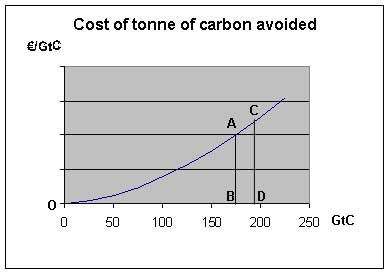

Nuclear Energy: too little too late?
by Andrew Teller
Even a cursory glance through the international
press is sufficient to notice two highly correlated types of articles.
The first type is about decision-makers thinking of reviving the
nuclear option to combat climate change. The second type reports
pronouncements of skeptics claiming that nuclear energy is not
the answer to the climate change problem. Under various guises,
the arguments of the opponents boil down to two basic statements:
-
the share of nuclear energy in the global
primary energy supply is too small to make any noticeable
difference to the actual amount of carbon dioxide emissions;
-
it would take so much time launching a large-scale
nuclear programme that it would start to kick in too late
to achieve any useful purpose.
Let us examine these claims in turn. The first
one is usually supported by a figure: nuclear energy amounts to
6% only of the total primary energy supply. So the argument goes:
if nuclear energy helps to the tune of 6% only, we do not change
the magnitude of the global warming challenge in any noticeable
way if we renounce to nuclear power plants. This piece of reasoning
is very clear, very simple to understand and all too easy to accept.
A moment of reflection shows however that it takes two conditions
for granted: a) the world’s total energy production is the
right yardstick for measuring the contribution of nuclear energy
and b) there are carbon-free solutions available in sufficient
supply to permit avoiding (or replacing) NPPs at no extra cost.
Unsurprisingly, neither condition is fulfilled. The contribution
of nuclear energy must be assessed with respect to the objective
to be reached, which definitely not the same as achieving zero
CO2 emissions.
Two scientists from Princeton University have
come up with what is generally regarded as a realistic objective.
They show how world CO2 emissions could be stabilized
to the current level of 7GtC (yes, 7 billion
tonnes of carbon!) over the next fifty years despite an expected
steep increase in energy consumption . This objective translates
into avoiding the generation of 175 GtC during the said time span.
On the other hand, phasing nuclear energy out would add about
20 GtC to that burden. I conclude from this that nuclear energy’s
contribution to the fight against climate change is equal to 20/175,
i.e. 11.4%, and not 6%. Of course, one might easily argue that
11.4% is still not a lot. The picture will however be further
altered if we shift our attention to the financial aspect of the
matter. Carbon-free substitutes to nuclear power plants that would
be equally cost-effective are not available in large quantities.
Some wind farms might nowadays be competitive with NPPs as long
as their overall contribution remains marginal. Pushing the share
of wind energy beyond, say, 20% will leave the existing base-load
generating capacity (all fossil-fuelled and nuclear) unable to
compensate the intermittency of wind. This will require energy
storage devices and push the cost of wind electricity to levels
noticeably higher than those experienced so far. Other production
means, such as off-shore wind and solar electricity will be even
more expensive. We can therefore expect the cost of each additional
tonne of carbon avoided to become dearer and dearer, as depicted
in figure 1. The total cost of avoiding a certain amount of carbon
emissions is numerically equal to the area under the curve. So,
the cost of avoiding 175 GtC will be represented by area OAB.
If we must make up for the phase-out of nuclear energy, we’ll
have to avoid 195 GtC and add to OAB a cost represented by area
ABCD. Therefore, the relative contribution of nuclear energy is
equal to the ratio ABCD/OAB. It is difficult to put precise figures
on the curve in figure 1. Just to give an order of magnitude of
the outcome that can be expected, it can be noted that, using
the curve below, a nuclear phase-out would increase the bill by
about 34%. One can assert that 34% is still not a lot. Should
anybody do so, I would then suggest looking at the absolute figures
lurking behind the percentages. According to an assessment made
at the Massachusetts Institute of Technology , the cost of avoiding
emissions of carbon in the (A-C) part of the curve in figure 1
could exceed 400 USD/tC for the United States. With a curve such
as the one depicted below, this would yield an average cost of
185 USD/tC. Let us not go to such extremes and assume conservatively
– and somewhat arbitrarily – an average cost of only
40 €/tC. Avoiding 175 GtC would then entail a cost of the
order of 7 000 billions €. I do not see how anybody could
possibly state that 34% of this amount is not a lot.

Figure 1
So much for the “too little” argument.
What can we say about the “too late” one? Opponents
of nuclear energy are quick to point out that the deployment of
a sizeable fleet of new reactors would take decades and would
consequently come after the death of the patient. I agree with
the premise but not with the conclusion. Scaling up the current
industrial capacity to meet increased demand will take time, but
so will the implementation of additional gas transport capacity,
or of wind farms capable of storing energy to be released when
the wind does not blow. So will also achieving meaningful energy
savings through better thermal efficiency in buildings or improved
transport habits. Clearly, this argument sounds more like a lame
excuse for dodging the nuclear option: lead time problems are
not insuperable. Furthermore, while it is reasonable to start
working on the problem now, it would be unreasonable to demand
tangible results tomorrow. The article mentioned above under reference
1 confirms that 50 years is an appropriate time span for planning
our actions and reaping the benefits thereof. This leaves nuclear
energy ample time to provide an orderly and not-to-be-dismissed
contribution to the fight against global warming.
1 S. Pacala & R. Socolow Stabilization
Wedges: Solving the Climate Problem for the Next 50
Years with Current Technologies, Science, vol 305,
13 August 2004.
2 MIT Joint Program on the Science and Policy of Global
Change, April 2000 (reprinted from Making Technology Work (p 105)
by John M. Deutch & Richard K. Lester, Cambridge University
Press, 2004)
|







